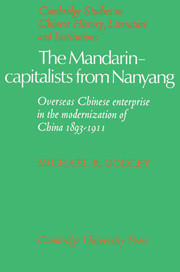 The Mandarin-Capitalists from Nanyang
The Mandarin-Capitalists from Nanyang Published online by Cambridge University Press: 23 September 2009
Chang Pi-shih's twelve-point memorial for the modernization of China was a truly progressive and all-inclusive document. First submitted to the empress dowager and the Board of Trade in mid-1903, his suggestions on how China might make commerce flourish were thoroughly discussed at the highest levels. The contents ranged from a discussion of the traditional problems of agriculture to the standardization of weights and measures and on to the construction of a system of branch railroads. The twelve major topics, as presented in the original document, provide an introductory summary of the scope of the matters discussed. Chang urged:
I. The recruitment of merchants to undertake the management of agriculture, industry, railroads and mines.
II. The recruitment of merchants to promote the opening of hill land for cultivation.
III. Discussion of the advantages of opening the hills for cultivation.
IV. Discussion of the advantages of beginning mining operations in the hill lands.
V. The recruitment of merchants to put irrigation and water conservation schemes into operation.
VI. Water conservation should be planned and managed on both cultivated and uncultivated land.
VII. The recruitment of merchants to set up credit to the tiller associations.
VIII. The recruitment of merchants to begin technical operations and to hire workers.
IX. The recruitment of merchants to begin the management of branch railroads.
X. The recruitment of Chinese merchants abroad.
XI. The unification of units of measurement.
XII. Increasing the number of commercial officials in the various provinces.
To save this book to your Kindle, first ensure [email protected] is added to your Approved Personal Document E-mail List under your Personal Document Settings on the Manage Your Content and Devices page of your Amazon account. Then enter the ‘name’ part of your Kindle email address below. Find out more about saving to your Kindle.
Note you can select to save to either the @free.kindle.com or @kindle.com variations. ‘@free.kindle.com’ emails are free but can only be saved to your device when it is connected to wi-fi. ‘@kindle.com’ emails can be delivered even when you are not connected to wi-fi, but note that service fees apply.
Find out more about the Kindle Personal Document Service.
To save content items to your account, please confirm that you agree to abide by our usage policies. If this is the first time you use this feature, you will be asked to authorise Cambridge Core to connect with your account. Find out more about saving content to Dropbox.
To save content items to your account, please confirm that you agree to abide by our usage policies. If this is the first time you use this feature, you will be asked to authorise Cambridge Core to connect with your account. Find out more about saving content to Google Drive.